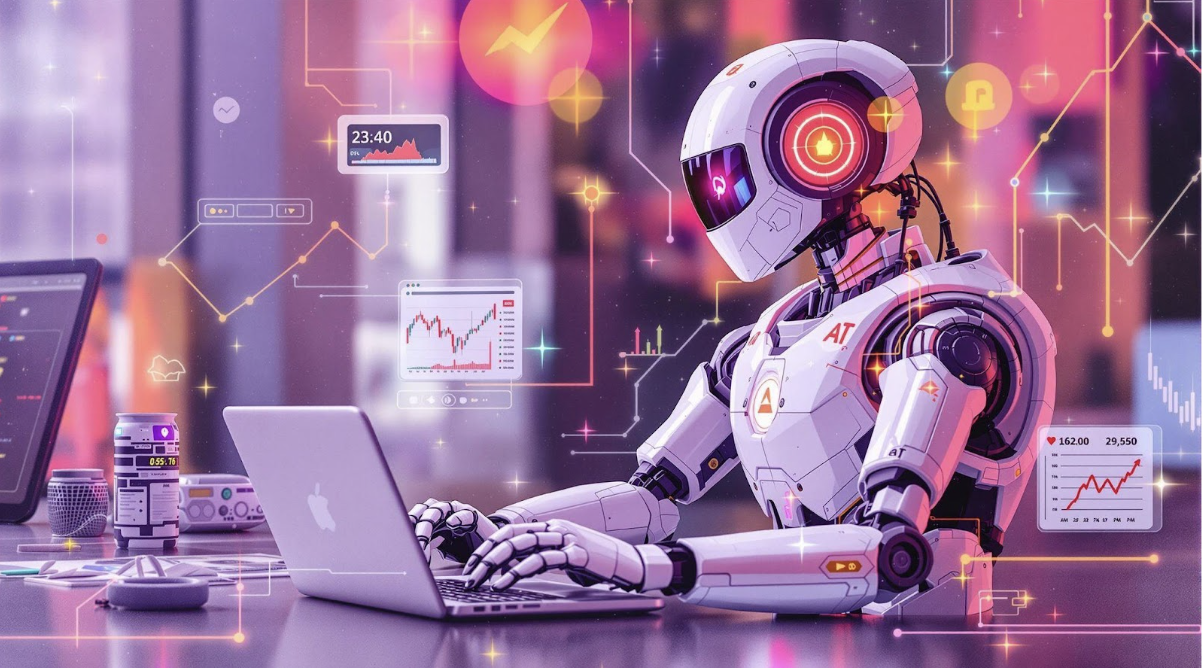In today's rapidly evolving cryptocurrency market, the implementation of artificial intelligence in trading has become increasingly crucial for success. Whether you're a seasoned trader or just starting out, using a reliable trade bot can significantly enhance your trading strategy by automating processes and reducing emotional decision-making. This comprehensive guide will walk you through the essential steps of training an AI bot for cryptocurrency trading using real market data. The emergence of sophisticated AI technologies has revolutionized how traders approach the cryptocurrency market, offering unprecedented opportunities for automated and efficient trading strategies.
Understanding AI Crypto Trading Bots

AI crypto trading bots represent a significant evolution from traditional trading algorithms. These sophisticated pieces of software utilize artificial intelligence and machine learning to analyze market data, identify patterns, and execute trades automatically. Unlike conventional trading bots that follow pre-programmed rules, AI-powered solutions can adapt dynamically to market conditions.
The fundamental difference between traditional algorithmic trading and AI-powered solutions lies in their ability to learn and evolve. While traditional bots execute fixed strategies, AI bots can adjust their approach based on market performance and new data inputs. This adaptive capability makes them particularly valuable in the volatile cryptocurrency market.
Key features of modern AI trading bots include:
Advanced Decision Making:
- Complex pattern recognition capabilities
- Real-time market analysis with millisecond precision
- Multi-dimensional correlation detection
- Dynamic strategy modification based on market conditions
- Integration of multiple trading indicators and signals
Data Processing Capabilities:
- High-frequency trading support with minimal latency
- Natural language processing for news and social media analysis
- Advanced sentiment analysis across multiple platforms
- Deep market structure analysis
- Sophisticated order book pattern recognition
Automated Learning Features:
- Self-improving algorithms that evolve with market conditions
- Comprehensive historical data analysis capabilities
- Continuous performance optimization routines
- Strategy refinement based on success metrics
- Adaptive risk management protocols
These capabilities allow AI trading bots to operate with a level of sophistication that was previously impossible with traditional trading methods. They can process and analyze vast amounts of data in real-time, making them particularly effective in the fast-paced cryptocurrency market.
Prerequisites for Bot Training

Technical Requirements
Before beginning the training process, ensure you have established a robust technical foundation:
- High-performance computing system (minimum 16GB RAM, multi-core processor)
- Enterprise-grade internet connection with sub-100ms latency
- Comprehensive historical data spanning at least 2 years
- Advanced programming knowledge in Python, R, or similar languages
- Secured API access to multiple cryptocurrency exchanges
- Substantial storage capacity (minimum 1TB) for data processing
- Backup systems and redundancy protocols
- Development environment with version control
Knowledge Requirements
Success in AI bot training demands a diverse skill set:
- Deep understanding of cryptocurrency market mechanics
- Intermediate to advanced machine learning concepts
- Expertise in technical analysis and indicators
- Comprehensive risk management principles
- Advanced data analysis and statistical modeling
- Basic cryptography and blockchain technology
- Network security best practices
- Financial market fundamentals
- Trading psychology understanding
Step-by-Step Training Process
Data Collection and Preparation
Essential data components and processing steps:
Data Types Required:
- High-resolution price data (OHLCV)
- Complete trading volume records
- Market depth and order book snapshots
- Sentiment indicators from multiple sources
- Social media engagement metrics
- On-chain transaction data
- Exchange-specific indicators
- Macroeconomic factors
Data Processing Pipeline:
- Automated data cleaning algorithms
- Advanced normalization techniques
- Custom feature engineering
- Time series synchronization
- Sophisticated outlier detection
- Format standardization protocols
- Data integrity verification
- Real-time data feed integration
Advanced Training Techniques
Deep learning integration represents one of the most sophisticated aspects of AI trading bot development. Modern neural network architectures enable bots to process complex market patterns and relationships that would be impossible to identify through traditional analysis. The implementation begins with carefully designed network structures, typically utilizing multiple layers of neurons that can identify both simple and complex patterns in market data.
For effective machine learning integration, developers must focus on several key areas. First, the neural network architecture must be specifically designed for financial market analysis, with consideration for time-series data processing and real-time decision making. This involves creating specialized layers that can handle both historical and live market data streams simultaneously.
Feature selection and engineering play a crucial role in the training process. The system must be trained to identify relevant market indicators while filtering out noise. This requires sophisticated data preprocessing techniques and careful consideration of which features provide meaningful predictive value. Successful implementations often combine traditional technical indicators with novel features derived from market microstructure analysis.
Hyperparameter tuning represents another critical component of the training process. This involves systematic optimization of various model parameters such as learning rate, batch size, and network depth. Modern approaches utilize automated tuning processes that can test thousands of parameter combinations to find optimal settings for specific market conditions.
The integration process also includes implementing ensemble methods, where multiple models work together to make trading decisions. This approach helps reduce the risk of individual model bias and increases the robustness of the trading system. Transfer learning techniques are employed to adapt successful strategies from one market to another, significantly reducing the time required for training new models.
Pattern Recognition Training
Pattern recognition in cryptocurrency trading requires sophisticated analysis of multiple data dimensions. The system must be trained to identify not just traditional chart patterns, but also complex market behaviors that emerge from the interaction of various factors. This includes monitoring order flow dynamics, analyzing market depth changes, and detecting institutional trading patterns.
The training process incorporates both technical and fundamental pattern analysis. Technical pattern recognition focuses on identifying classical chart formations, such as head and shoulders, double tops, and various triangle patterns, but with an advanced AI twist that considers market context and validity probability. The system learns to distinguish between high-probability and low-probability setups based on historical success rates.
Market sentiment analysis forms another crucial component, where the bot processes news feeds, social media trends, and on-chain metrics to identify potential market-moving events. This multi-dimensional approach allows the system to develop a comprehensive understanding of market dynamics.
Risk Management and Monitoring
Effective risk management serves as the cornerstone of successful AI trading operations. A comprehensive risk framework must include:
Position Management Systems:
- Dynamic position sizing based on market volatility
- Automated stop-loss adjustment mechanisms
- Take-profit optimization algorithms
- Portfolio exposure limits with real-time monitoring
- Risk-parity position allocation
- Correlation-based risk adjustment
Real-time Monitoring Protocols:
- Performance metric tracking across multiple timeframes
- Strategy effectiveness evaluation systems
- Risk exposure assessment tools
- Market condition analysis frameworks
- System health monitoring dashboards
- Execution quality analysis
These systems must operate continuously, providing immediate alerts when risk parameters are breached or when unusual market conditions are detected.
Common Challenges and Solutions
Trading bot development faces numerous technical and operational challenges that require systematic solutions. Most commonly, developers encounter issues with data quality and consistency, particularly when aggregating information from multiple sources. To address this, implementing robust data validation protocols and redundant data feeds becomes essential.
Technical challenges often include:
- Server downtime and connectivity issues
- API rate limiting constraints
- Processing power bottlenecks
- Data synchronization problems
- System latency issues
Effective solutions typically involve:
- Implementing redundant server architecture
- Developing sophisticated queue management systems
- Utilizing distributed processing frameworks
- Creating automated failover mechanisms
- Establishing robust error handling protocols
Performance Evaluation
Comprehensive performance evaluation requires monitoring multiple metrics simultaneously:
Quantitative Metrics:
- Risk-adjusted return calculations (Sharpe, Sortino ratios)
- Maximum drawdown analysis
- Win-rate and profit factor calculations
- Return on investment (ROI) tracking
- Volatility-adjusted performance metrics
Comparative Analysis:
- Benchmark performance tracking
- Peer strategy comparison
- Market correlation studies
- Risk-adjusted metric analysis
- Long-term sustainability assessment
Conclusion
Successfully training an AI bot for cryptocurrency trading requires a methodical approach combining technical expertise with market understanding. The key to long-term success lies in maintaining a balance between aggressive performance optimization and robust risk management. Regular system updates and continuous monitoring ensure the bot remains competitive in evolving market conditions.
Key success factors include:
- Rigorous testing and validation procedures
- Continuous strategy refinement and adaptation
- Strong risk management implementation
- Regular performance review and optimization
- Ongoing system maintenance and updates
Remember that successful AI trading bot development is an iterative process requiring patience and persistent refinement. Stay committed to regular updates and improvements, and always prioritize risk management over short-term gains. With proper implementation and monitoring, an AI trading bot can become a valuable tool in your cryptocurrency trading arsenal.





 usdt
usdt bnb
bnb

